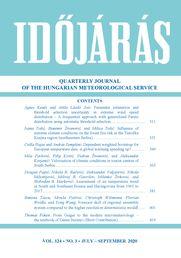IDŐJÁRÁS - angol nyelvű folyóirat
Vol. 124, No. 3 * Pages 311–426 * July - September 2020
 |
|
 letöltés [pdf: 3459 KB]
letöltés [pdf: 3459 KB]
Parameter estimation and threshold selection uncertainty in extreme wind speed distribution – A frequentist approach with generalized Pareto distribution using automatic threshold selection
Ágnes Kenéz and Attila László Joó
DOI:10.28974/idojaras.2020.3.1 (pp. 311–330)
Ágnes Kenéz and Attila László Joó
DOI:10.28974/idojaras.2020.3.1 (pp. 311–330)
Influence of extreme climate conditions on the forest fire risk in the Timočka Krajina region (northeastern Serbia)
Ivana Tošić, Stanimir Živanović, and Milica Tošić
DOI:10.28974/idojaras.2020.3.2 (pp. 331–347)
Ivana Tošić, Stanimir Živanović, and Milica Tošić
DOI:10.28974/idojaras.2020.3.2 (pp. 331–347)
Dependent weighted bootstrap for European temperature data: is global warming speeding up?
Csilla Hajas and András Zempléni
DOI:10.28974/idojaras.2020.3.3 (pp. 349–361)
Csilla Hajas and András Zempléni
DOI:10.28974/idojaras.2020.3.3 (pp. 349–361)
Valorisation of climate conditions in tourist centers of South Serbia
Mila Pavlović, Filip Krstić, Vedran Živanović, and Aleksandar Kovjanić
DOI:10.28974/idojaras.2020.3.4 (pp. 363–380)
Mila Pavlović, Filip Krstić, Vedran Živanović, and Aleksandar Kovjanić
DOI:10.28974/idojaras.2020.3.4 (pp. 363–380)
Assessment of air temperature trend in South and Southeast Bosnia and Herzegovina from 1961 to 2017
Dragan Papić, Nikola R. Bačević, Aleksandar Valjarević, Nikola Milentijević, Milivoj B. Gavrilov, Milenko Živković, and Slobodan B. Marković
DOI:10.28974/idojaras.2020.3.5 (pp. 381–399)
Dragan Papić, Nikola R. Bačević, Aleksandar Valjarević, Nikola Milentijević, Milivoj B. Gavrilov, Milenko Živković, and Slobodan B. Marković
DOI:10.28974/idojaras.2020.3.5 (pp. 381–399)
Forecast skill of regional ensemble system compared to the higher resolution deterministic model
Simona Tascu, Mirela Pietrisi, Christoph Wittmann, Florian Weidle, and Yong Wang
DOI:10.28974/idojaras.2020.3.6 (pp. 401–418)
Simona Tascu, Mirela Pietrisi, Christoph Wittmann, Florian Weidle, and Yong Wang
DOI:10.28974/idojaras.2020.3.6 (pp. 401–418)
From Geiger to the modern micrometeorology – the textbook of Dénes Berényi (Short Contribution)
Thomas Foken
DOI:10.28974/idojaras.2020.3.7 (pp. 419–426)
Thomas Foken
DOI:10.28974/idojaras.2020.3.7 (pp. 419–426)
IDŐJÁRÁS folyóirat

Az IDŐJÁRÁS a HungaroMet Nonprofit Zrt. negyedévenként megjelenő angol nyelvű folyóirata
Megrendelhető a journal.idojaras@met.hu címen.
A szerzőknek szánt útmutató itt olvasható.
Megrendelhető a journal.idojaras@met.hu címen.
A szerzőknek szánt útmutató itt olvasható.









